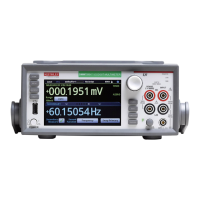7½ Digit Graphical Sampling Multimeter Reference Manual Section 3:
DMM7510-901-01 Rev. B / May 2015 3-53
Input
When you place a line in input mode, it is automatically set high to allow it to respond to and detect
externally generated triggers. Depending on the input edge detection setting, the line can detect
falling-edge triggers, rising-edge triggers, or both.
The line cannot generate an output trigger if it is set to the trigger input mode.
Synchronous triggering
The synchronous triggering modes allow you to:
• Implement bidirectional triggering on a single trigger line
• Start operations on one or more external instruments using a single trigger line
• Wait for all instruments to complete all triggered actions
To coordinate non-Keithley instrumentation with synchronous triggering, the non-Keithley instrument
must have a trigger mode that is similar to the synchronous acceptor or synchronous master trigger
mode.
To use synchronous triggering, configure the triggering master to synchronous master trigger mode
or the non-Keithley equivalent. Configure all other instruments in the test system to the synchronous
acceptor trigger mode or equivalent.
Synchronous master
Use the synchronous master trigger mode with the synchronous acceptor mode or its non-Keithley
equivalent.
Configure only one instrument as a synchronous master. Configure all other instruments that are
connected to the synchronization line as synchronous acceptors.
When a digital I/O line is set to the synchronous master mode, it generates falling edge output
triggers and detects rising edge input triggers on the same trigger line.
Instruments that are configured as synchronous acceptors detect the falling-edge trigger and begin
their triggered actions. At the same time, they latch the line low and hold it in that state until their
triggered actions complete. Each instrument configured as an acceptor releases the line upon
completion of its triggered actions.
When all instruments have released the line, the line changes state and generates a rising edge
trigger. This trigger is detected by the synchronous master, which then performs its next triggered
action.

